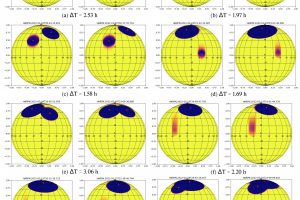Developed a metjod aimed at characterizing spots in active stars. The paper: “The GAPS programme at TNG LII. Spot modeling of V1298 Tau using SpotCCF tool” of C. di Mario (INAF – OAPA) recently appeared on A&A

The Sun regularly exhibits magnetic phenomena, including sunspots and solar flares, which are not only visually appealing but also crucial for in-depth study and understanding. This is because these phenomena arise from large-scale interactions between the solar magnetic field and its plasma. Moreover, they provide valuable insights into the structure of the Sun and its atmosphere.
Almost all other stars in the Universe exhibit similar phenomena, which, however, we cannot directly resolve and observe due to the large distances involved, even for the closest stars. The sole exception is a small sample of supergiant stars, where it has been possible to resolve photospheric structures using specific observational techniques. Nonetheless, studying stellar activity is crucial for several reasons. It can provide insights into the evolution of the internal structure of stars, is associated with the emission of energetic radiation that can influence the surrounding environment, and can produce signals that may complicate our ability to detect planets around these stars.
It is important to develop techniques that allow us to study the magnetic activity in stars. A team led by astronomer C. di Maio (INAF – Astronomical Observatory of Palermo) has recently introduced a new method called SpotCCF, designed for characterizing spots in the photosphere of active stars. The method utilizes spectroscopic observations, which are combined with masks accounting for Doppler effects induced by stellar rotation and the presence of spots. Due to stellar rotation, in fact, the projected velocity along the line of sight of photospheric elements changes with longitude, being slower at the center of the stellar disc and faster along the border. This effect induces a deformation of the stellar spectrum, sensitive to the presence of photospheric spots. SpotCCF is constructed to identify spots based on this effect and provide information about their properties.
The paper titled “The GAPS programme at TNG LII. Spot modeling of V1298 Tau using SpotCCF tool,” recently accepted for publication by Astronomy & Astrophysics, introduces SpotCCF and presents the results of its application to spectroscopic observations of V1298 Tau. This young star, with an age of 23 million years, is similar to the Sun and is characterized by rapid rotation and intense magnetic activity. Analyzing 300 spectroscopic observations taken with the HARPS-N spectrograph mounted on the Telescopio Nazionale Galileo, and processed using SpotCCF, the authors have demonstrated the presence of two large blocks of spots on the surface of V1298 Tau. One block is at a high latitude (>60°) with a filling factor (the fraction of the stellar photosphere covered by spots) of about 4%, while the other is at a latitude <50° with a similar filling factor. This technique will be useful in the future for describing spot properties in active stars and incorporating them into observations aimed at searching for exoplanets.
The cover figure (click here to visualize entirely) shows the spot configurations in V1298 Tau synthetised using SpotCCF.
Mario Giuseppe Guarcello ( follow mariospiegacose) ( mariospiegacose) ( follow mariospiegacose)
Follow the Astronomical Observatory of Palermo on Facebok and on Instagram
Subscribe the Youtube channel of the Astronomical Observatory of Palermo
